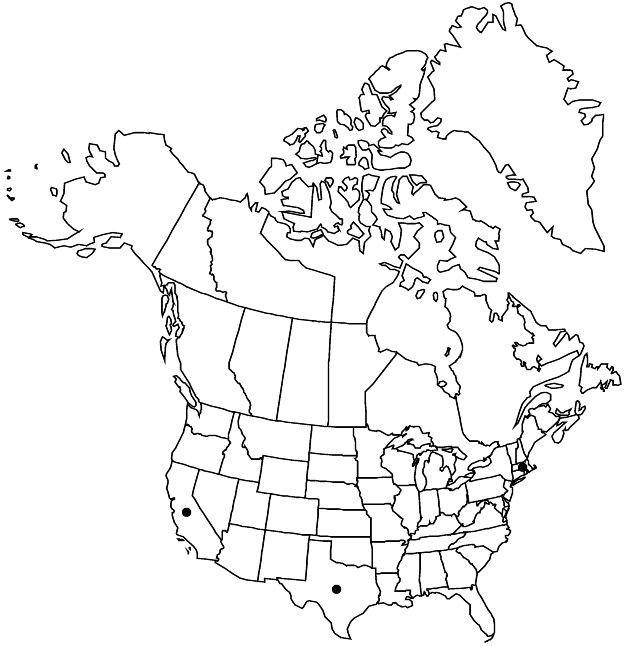Difference between revisions of "Citrullus colocynthis"
Linnaea 12: 414. 1838.
FNA>Volume Importer |
imported>Volume Importer |
||
| (6 intermediate revisions by 2 users not shown) | |||
| Line 12: | Line 12: | ||
|label=Introduced | |label=Introduced | ||
}} | }} | ||
| − | |basionyms={{Treatment/ID/ | + | |basionyms={{Treatment/ID/Basionym |
|name=Cucumis colocynthis | |name=Cucumis colocynthis | ||
|authority=Linnaeus | |authority=Linnaeus | ||
| + | |rank=species | ||
| + | |publication_title=Sp. Pl. | ||
| + | |publication_place=2: 1011. 1753 | ||
}} | }} | ||
|synonyms={{Treatment/ID/Synonym | |synonyms={{Treatment/ID/Synonym | ||
|name=Colocynthis vulgaris | |name=Colocynthis vulgaris | ||
|authority=Schrader | |authority=Schrader | ||
| + | |rank=species | ||
}} | }} | ||
|hierarchy=Cucurbitaceae;Citrullus;Citrullus colocynthis | |hierarchy=Cucurbitaceae;Citrullus;Citrullus colocynthis | ||
| Line 34: | Line 38: | ||
|elevation=0–100 m | |elevation=0–100 m | ||
|distribution=Calif.;Mass.;Tex.;Africa;introduced also in Europe;Asia;Pacific Islands;Australia. | |distribution=Calif.;Mass.;Tex.;Africa;introduced also in Europe;Asia;Pacific Islands;Australia. | ||
| − | |discussion=<p>Citrullus colocynthis is a traditional food plant in Africa, where it is grown particularly for its edible seeds, which are bitter but nutty-flavored, rich in fat and protein, and eaten whole or used as an oilseed. It has also been a standard cathartic remedy, mostly in combination with other cathartics.</p><!-- | + | |introduced=true |
| + | |discussion=<p><i>Citrullus colocynthis</i> is a traditional food plant in Africa, where it is grown particularly for its edible seeds, which are bitter but nutty-flavored, rich in fat and protein, and eaten whole or used as an oilseed. It has also been a standard cathartic remedy, mostly in combination with other cathartics.</p><!-- | ||
--><p>Three main haplotypes within colocynth have been identified via molecular data (F. Dane and P. Lang 2004; Dane and J. Liu 2007; A. Levi and C. E. Thomas 2005).</p><!-- | --><p>Three main haplotypes within colocynth have been identified via molecular data (F. Dane and P. Lang 2004; Dane and J. Liu 2007; A. Levi and C. E. Thomas 2005).</p><!-- | ||
--><p>Colocynth rarely is encountered outside of cultivation. It has been reported as a weed in Texas peanut fields (G. L. Nesom 2011); in Massachusetts, it has been sporadically collected since 1878; in California, it has been collected on a pond dike in an area of cotton fields in Kern County.</p> | --><p>Colocynth rarely is encountered outside of cultivation. It has been reported as a weed in Texas peanut fields (G. L. Nesom 2011); in Massachusetts, it has been sporadically collected since 1878; in California, it has been collected on a pond dike in an area of cotton fields in Kern County.</p> | ||
| Line 45: | Line 50: | ||
-->{{#Taxon: | -->{{#Taxon: | ||
name=Citrullus colocynthis | name=Citrullus colocynthis | ||
| − | |||
|authority=(Linnaeus) Schrader | |authority=(Linnaeus) Schrader | ||
|rank=species | |rank=species | ||
| Line 61: | Line 65: | ||
|publication year=1838 | |publication year=1838 | ||
|special status=Introduced | |special status=Introduced | ||
| − | |source xml=https:// | + | |source xml=https://bitbucket.org/aafc-mbb/fna-data-curation/src/2e0870ddd59836b60bcf96646a41e87ea5a5943a/coarse_grained_fna_xml/V6/V6_67.xml |
|genus=Citrullus | |genus=Citrullus | ||
|species=Citrullus colocynthis | |species=Citrullus colocynthis | ||
Latest revision as of 22:22, 5 November 2020
Vines perennial. Stems trailing, 50–150 cm, pustulate-scabrous to pustulate-hispid and sparsely hirsute with deflexed hairs; roots fleshy to ± woody, tuberous; tendrils usually unbranched, rarely 2-branched. Leaf blades elongate-ovate, 1–6(–11) cm, 3–5(–7)-lobed, lobes pinnately shallowly lobed or sinuate, margins serrate to dentate, surfaces pustulate-scabrous. Flowers: hypanthium campanulate, 4–8 mm; sepals lanceolate to linear-lanceolate, 5 mm; petals obovate-oblong, 6–10 mm. Pepos variegated green and yellow or yellow, green-striped, globose to subglobose, with ± elliptical fissures, 4–7(–10) cm diam.; rind thin, not durable, mesocarp light yellowish orange to pale yellow, dry-spongy, intensely bitter. Seeds dark brown to yellowish orange, ovoid-oblong to ellipsoid, 6 mm. 2n = 22.
Phenology: Flowering Jun–Sep.
Habitat: Peanut fields, pond dikes in cotton fields, fallow fields, waste ground
Elevation: 0–100 m
Distribution

Introduced; Calif., Mass., Tex., Africa, introduced also in Europe, Asia, Pacific Islands, Australia.
Discussion
Citrullus colocynthis is a traditional food plant in Africa, where it is grown particularly for its edible seeds, which are bitter but nutty-flavored, rich in fat and protein, and eaten whole or used as an oilseed. It has also been a standard cathartic remedy, mostly in combination with other cathartics.
Three main haplotypes within colocynth have been identified via molecular data (F. Dane and P. Lang 2004; Dane and J. Liu 2007; A. Levi and C. E. Thomas 2005).
Colocynth rarely is encountered outside of cultivation. It has been reported as a weed in Texas peanut fields (G. L. Nesom 2011); in Massachusetts, it has been sporadically collected since 1878; in California, it has been collected on a pond dike in an area of cotton fields in Kern County.
Selected References
None.